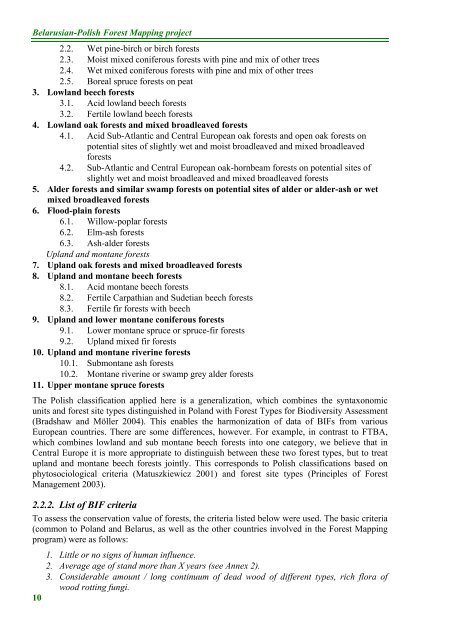Belarusian Polish Forest Mapping Belarusian Polish Forest Mapping
Belarusian Polish Forest Mapping Belarusian Polish Forest Mapping
Belarusian Polish Forest Mapping Belarusian Polish Forest Mapping
You also want an ePaper? Increase the reach of your titles
YUMPU automatically turns print PDFs into web optimized ePapers that Google loves.
<strong>Belarusian</strong>-<strong>Polish</strong> <strong>Forest</strong> <strong>Mapping</strong> project<br />
2.2. Wet pine-birch or birch forests<br />
2.3. Moist mixed coniferous forests with pine and mix of other trees<br />
2.4. Wet mixed coniferous forests with pine and mix of other trees<br />
2.5. Boreal spruce forests on peat<br />
3. Lowland beech forests<br />
3.1. Acid lowland beech forests<br />
3.2. Fertile lowland beech forests<br />
4. Lowland oak forests and mixed broadleaved forests<br />
4.1. Acid Sub-Atlantic and Central European oak forests and open oak forests on<br />
potential sites of slightly wet and moist broadleaved and mixed broadleaved<br />
forests<br />
4.2. Sub-Atlantic and Central European oak-hornbeam forests on potential sites of<br />
slightly wet and moist broadleaved and mixed broadleaved forests<br />
5. Alder forests and similar swamp forests on potential sites of alder or alder-ash or wet<br />
mixed broadleaved forests<br />
6. Flood-plain forests<br />
6.1. Willow-poplar forests<br />
6.2. Elm-ash forests<br />
6.3. Ash-alder forests<br />
Upland and montane forests<br />
7. Upland oak forests and mixed broadleaved forests<br />
8. Upland and montane beech forests<br />
8.1. Acid montane beech forests<br />
8.2. Fertile Carpathian and Sudetian beech forests<br />
8.3. Fertile fir forests with beech<br />
9. Upland and lower montane coniferous forests<br />
9.1. Lower montane spruce or spruce-fir forests<br />
9.2. Upland mixed fir forests<br />
10. Upland and montane riverine forests<br />
10.1. Submontane ash forests<br />
10.2. Montane riverine or swamp grey alder forests<br />
11. Upper montane spruce forests<br />
The <strong>Polish</strong> classification applied here is a generalization, which combines the syntaxonomic<br />
units and forest site types distinguished in Poland with <strong>Forest</strong> Types for Biodiversity Assessment<br />
(Bradshaw and Möller 2004). This enables the harmonization of data of BIFs from various<br />
European countries. There are some differences, however. For example, in contrast to FTBA,<br />
which combines lowland and sub montane beech forests into one category, we believe that in<br />
Central Europe it is more appropriate to distinguish between these two forest types, but to treat<br />
upland and montane beech forests jointly. This corresponds to <strong>Polish</strong> classifications based on<br />
phytosociological criteria (Matuszkiewicz 2001) and forest site types (Principles of <strong>Forest</strong><br />
Management 2003).<br />
2.2.2. List of BIF criteria<br />
To assess the conservation value of forests, the criteria listed below were used. The basic criteria<br />
(common to Poland and Belarus, as well as the other countries involved in the <strong>Forest</strong> <strong>Mapping</strong><br />
program) were as follows:<br />
10<br />
1. Little or no signs of human influence.<br />
2. Average age of stand more than X years (see Annex 2).<br />
3. Considerable amount / long continuum of dead wood of different types, rich flora of<br />
wood rotting fungi.

















